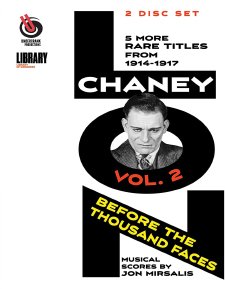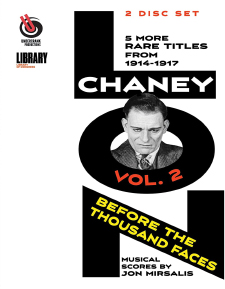Lon Chaney: Before the Thousand Faces – Volume 2 (Blu-ray Review)

Director
VariousRelease Date(s)
1914-1917 (August 2, 2022)Studio(s)
Universal Pictures (Undercrank Productions)- Film/Program Grade: See Below
- Video Grade: See Below
- Audio Grade: See Below
- Extras Grade: N/A
- Overall Grade: B+
Review
Lon Chaney’s films of the 1920s are well known, especially the classics The Hunchback of Notre Dame and The Phantom of the Opera, and are readily available on home video. Of Chaney’s 1920’s output, only A Blind Bargain and London After Midnight have not been found. In the 1910s, Chaney made 111 films and only 24 of them survive. None of these has ever been available, until now. Lon Chaney: Before the Thousand Faces – Volume 2 contains five of his early films. Some have not survived in complete form, so missing scenes and intertitles are reconstructed whenever possible.
By the Sun’s Ray, the earliest film in the collection (1914), features Lon Chaney in a Western as Frank Lawler, who works in the office of a mine. He’s in love with the superintendent’s daughter. She, however, has eyes for a handsome new detective whose identity remains unknown to Lawler. When a gold shipment is sent out, Lawler signals bandits to intercept it, but the plot is discovered, the theft foiled, and Lawler is killed trying to escape.
The film was shot with spherical lenses on black-and-white 35 mm film and presented in the aspect ratio of 1.33:1. (The director of photography is uncredited.) A private collector in England had a print of unknown origin that was copied and released in the 1970s in the Super 8 format. The version in the new release comes from a 16 mm negative made from that Super 8 print. This release is sepia-tinted and exhibits considerable damage, such as splices, scratches, ingrained surface dirt, and jump cuts.
The Oubliette is Part 1 of a large 1914 production intended to be released as a series titled The Adventures of Francois Villon. Villon is a vagabond and poet on his way to Paris with his friend Colin. Villon encounters Chevalier Bertran de la Payne (Lon Chaney), who’s holding a lady, Philipppa de Annonay, against her will. Villon engages de la Payne in a sword fight and kills him. Chaney appears briefly in the second reel and reappears as a different character in Part 2, The Higher Law, which is not known to have survived.
The Oubliette was shot by director of photography Lee Bartholomew with spherical lenses on black-and-white 35 mm film and presented in the aspect ratio of 1.33:1. This is the earliest of Chaney’s surviving 3-reelers. It resurfaced in 1983 when a couple in Georgia found the reels in metal cans under their porch. The 35 mm nitrate print was in excellent condition. The first 2 reels are black-and-white but the third is multi-tinted. The only major defects are occasional scratches.
The Millionaire Paupers, released in 1915, centers on Enid Barne-Smith who flees home to escape her mother’s planned marriage to Allen Winthrop, whom the girl has never met. She takes up residence in a tenement owned by Winthrop and managed by Albert Martin (Lon Chaney). Winthrop disguises himself as a tenant in that building to investigate allegations of Martin’s crooked dealings. Enid and Allen meet, neither knowing the true identity of the other, and become mutually attracted.
The film was shot with spherical lenses on 35 mm black-and-white film and presented in the aspect ratio of 1.33:1. Once again, the director of photography is uncredited. This 3-reel film was considered lost until a brief 35 mm nitrate fragment was discovered in 1992 by a film collector. The surviving footage has significant damage and nitrate decomposition.
Triumph from 1917 is a show-biz themed melodrama about a young woman who aspires to a career on Broadway. Nell Baxter meets the leading man of a theatrical repertory troupe. In New York City, stage manager David Montieth (Lon Chaney) promises her the leading role in a play if she returns the favor in a physical way. Nell falls for playwright Paul Neihoff. The day the show is to open, Montieth finds out about Nell's love affair with Neihoff and cancels the play. Only if Nell capitulates to Montieth will he open the play. When Montieth forces himself on her, she stabs him to death and runs to Neihoff to confess. He tells her to go on stage, and he confesses to the murder he didn’t commit. In the third act, Nell substitutes a real dagger for the prop dagger and kills herself. In the end, we learn that what we’ve seen was a story concocted by the leading man to show Nell that life in the theater isn’t all glamour.
Triumph was shot by director of photography King D. Gray with spherical lenses on 35 mm black-and-white film and presented in the aspect ratio of 1.33:1. An incomplete nitrate print was discovered by a collector in the early 1990s. Reels 1-3 of the 5-reel picture were preserved by the Academy of Motion Picture Arts & Sciences, but Reels 4-5 remain lost. Reel 3 had significant nitrate decomposition. The missing reels have been reconstructed with titles from a complete synopsis filed with the Library of Congress as part of the original copyright application. Considerable surface dirt, scratches, and lighting shifts are visible.
The Scarlet Car, also from 1917, deals with embezzlement and the abuse of power. After nearly driving his father into bankruptcy, Billy Winthrop vows to reform. He’s in love with Beatrice Forbes, daughter of Paul Revere Forbes (Lon Chaney), a cashier at the local bank. Forbes discovers that Peabody, the bank president, has lost $35,000 of bank funds to speculation. Forbes confronts Peabody, they struggle, and Forbes is apparently killed. Peabody stages an accident to explain Forbes’ death, but by morning the body is gone. Beatrice is pressured into marrying Peabody’s son, but Billy rescues her. They take shelter in an abandoned cabin in which Forbes has also taken refuge. His mind is gone and he believes himself to be a messenger from his famous relative, Paul Revere. The missing funds are discovered and Peabody blames Billy for the theft. The truth eventually comes out, a mob tars and feathers both of the Peabodys, and Beatrice and Billy are reunited. Chaney, in a wig and full beard, is unrecognizable. The role is as a forerunner of the many character make-ups he would create a decade later.
The film was shot by director of photography King D. Gray with spherical lenses on black-and-white 35 mm film and presented in the aspect ratio of 1.33:1. A nitrate print was included in a 35 mm collection purchased by the Library of Congress that was preserved in the 1970s. The print was complete, with a few out-of-order sequences that were reassembled for a restoration performed in 2001. The nitrate for Reel 2 had decomposed by then and the earlier safety negative of Reel 2 was used for the final restoration. The film is tinted mustard yellow for interiors and blue for outdoor scenes.
All films in this 2-Disc Blu-ray release are accompanied by new musical scores created and performed by Jon Mirsalis. There are no bonus materials, but each of the five films contains informative, textual introductions that provide information about the film’s story and its history of preservation.
BY THE SUN’S RAYS (FILM/VIDEO/AUDIO): C+/C/A
THE OUBLIETTE (FILM/VIDEO/AUDIO): B+/B/A
THE MILLIONAIRE PAUPERS (FILM/VIDEO/AUDIO): C+/C/A
TRIUMPH (FILM/VIDEO/AUDIO): B/C/A
THE SCARLET CAR (FILM/VIDEO/AUDIO): B+/B/A
These early films show Lon Chaney as a versatile character actor able to assume roles in various genres, though he was often cast as the villain. Lacking the typical good looks of a romantic leading man, he worked constantly and became a valued player because he was able to slip into many juicy parts as the chief antagonist. Eventually, his facility with make-up would propel him to the height of fame. No challenge was too great for the actor who became known as the “Man of a Thousand Faces.”
- Dennis Seuling

